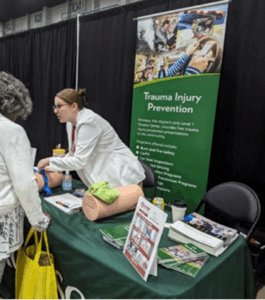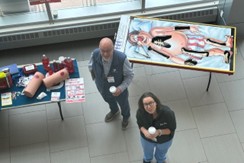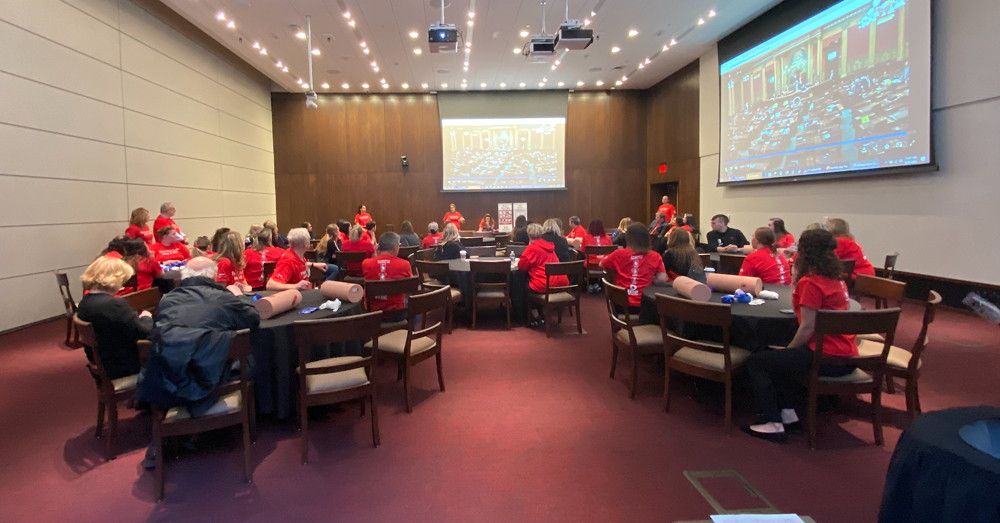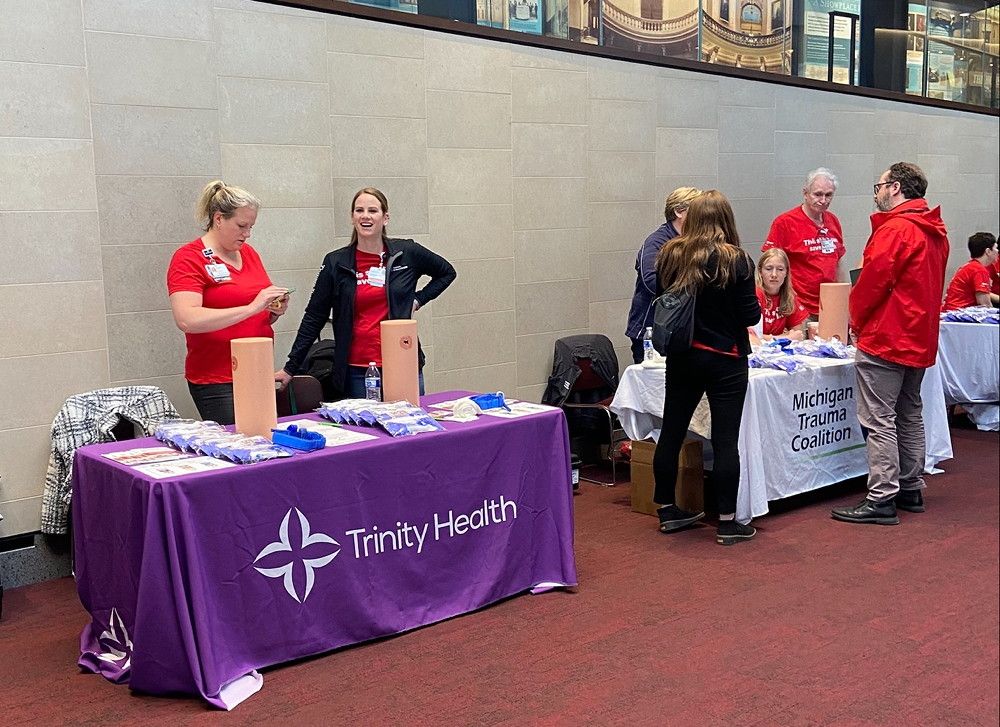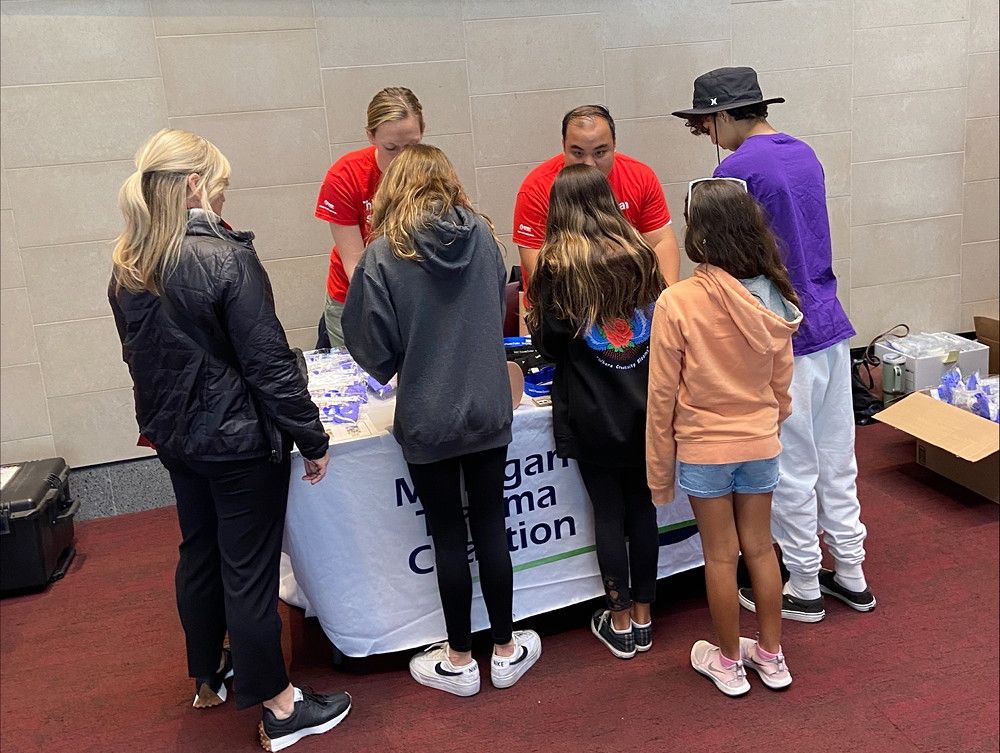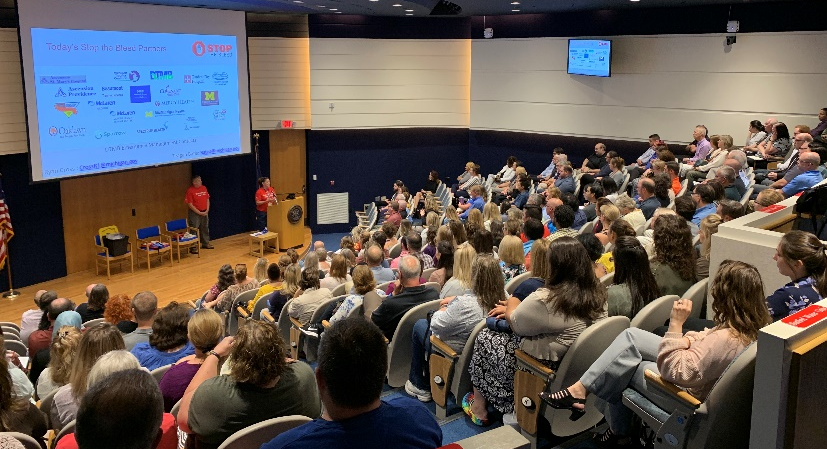MTC News
Stop the Bleed Day is simply an exciting time to share details around this life-saving program, and provide education in our communities.
Stop the Bleed training includes the effective use of emergency bleeding control kits, emergency preparedness, and advanced first aid procedures. There may be a Stop the Bleed kit near you accompanying the AED in schools, hospitals and public places. This vital initiative is also endorsed by the Michigan Legislature as they recognize the importance of this program with resolutions passed, and support for the program in schools, and many community levels.
Here are some exciting highlights of Stop the Bleed Initiatives that took place around the state of Michigan.
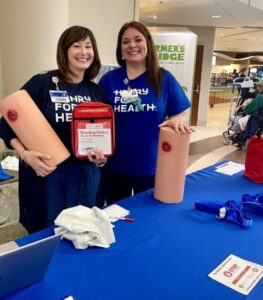 On May 22nd at West Bloomfield’s Henry Ford Health- Nicole Papalian and Vanessa Mier focused on the local and accessible Stop the Bleed kits inside of the hospital, and shared demonstrations with tourniquets, hands-on training, and certification information for staff and visitors. Vanessa and Nicole from Novi and West Bloomfield Henry Ford hospitals also discussed the importance of trauma and injury prevention, the Michigan Trauma Coalition, and Michigan’s vital trauma centers.
On May 22nd at West Bloomfield’s Henry Ford Health- Nicole Papalian and Vanessa Mier focused on the local and accessible Stop the Bleed kits inside of the hospital, and shared demonstrations with tourniquets, hands-on training, and certification information for staff and visitors. Vanessa and Nicole from Novi and West Bloomfield Henry Ford hospitals also discussed the importance of trauma and injury prevention, the Michigan Trauma Coalition, and Michigan’s vital trauma centers.
Each day, many people walk by the large Stop the Bleed kit near the hospital cafeteria, this was an ideal time to expand on the purpose of this kit, and there was fantastic feedback about the program from more than 150 people that we encountered. Stop the Bleed Champions discussed how sharing the Stop the Bleed program in schools, hospitals and in general civilian populations is a priority, and how to become involved. Also, we had an opportunity for people to sign-up and become certified.
Christina Cameron, MSN, RN from Bronson Hospital Trauma Services Participated in Stop the Bleed Day education and outreach at the Calhoun Senior Expo. Tourniquet demonstrations were done and 200 mini first aid kits with Stop the Bleed Education were distributed.
 Anita Barksdale, Trinity Health Oakland partnered with area Fire/EMS/Rescue services and Healing Hearts Cardiac Emergency Prevention Services to travel to high school medical track classes in high schools, senior communities with limited resources, and businesses to provide life-saving training on how to manage a life-threatening bleed and HANDS ONLY CPR throughout the month of May.
Anita Barksdale, Trinity Health Oakland partnered with area Fire/EMS/Rescue services and Healing Hearts Cardiac Emergency Prevention Services to travel to high school medical track classes in high schools, senior communities with limited resources, and businesses to provide life-saving training on how to manage a life-threatening bleed and HANDS ONLY CPR throughout the month of May.
Tera Richards, University of Michigan Health-West, May 2025 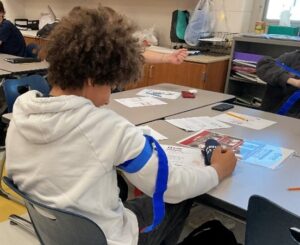
Students Gain Life-Saving Skills Through Stop the Bleed Training
On May 30th, just before the final days of the 2025 school year, students in a life skills class participated in hands-on training focused on bleeding control, using materials and guidance provided by the Stop the Bleed initiative. The session combined demonstration, direct instruction, and interactive practice.
Students self-assessed their knowledge and skills before and after the training using a 5-point scale, where 1 = Very Poor, 2 = Poor, 3 = Fair, 4 = Good, and 5 = Very Good. The results showed clear improvements across multiple areas:
· Knowledge of Bleeding Control: Average self-assessed scores rose from 3 (fair) to 4 (good).
· Skill Proficiency: Ability to perform bleeding control techniques improved from 2 (poor) to 4 (good).
· Emergency Readiness: Confidence in responding to a serious bleeding injury increased from 2 (poor) to 4 (good).
· Comfort with Equipment: Comfort using a bleeding control kit rose from 2 (poor) to 4 (good).
Beyond the quantitative gains, the energy and enthusiasm students showed while engaging with the Stop the Bleed materials demonstrate not only their interest in community health and safety…but also that impactful learning was taking place.
 Emma Chandler with Corewell Health Butterworth in Grand Rapids, hosted a Stop the Bleed event led by our general surgery residents.
Emma Chandler with Corewell Health Butterworth in Grand Rapids, hosted a Stop the Bleed event led by our general surgery residents.
In April 2025, the team extended this effort to Comstock Park High School, engaging approximately 500 students and staff in a dynamic and educational experience. The event began with a general assembly where the resident presented the Stop the Bleed Power Point.
Following the assembly, the students rotated through hands on skills station where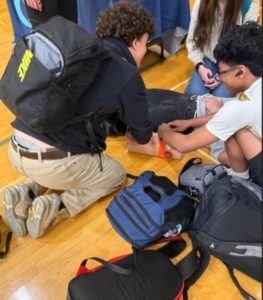 they practiced wound packing, holding pressure and tourniquet application under the guidance of the residents. Additional stations included
they practiced wound packing, holding pressure and tourniquet application under the guidance of the residents. Additional stations included
· Blood donation station where students were given the opportunity to donate blood
· Blood administration awareness where 3 members of our acute surgery team explained how donated blood is used in clinical settings to save lives.
To round out the event, the school hosted an impact speaker on mental health, emphasizing the importance of well-being and resilience in both everyday life and emergency situations.
Following this event, the district won an award for school wellness and in their success story discussed the importance of Stop the Bleed and the education they received during this event.
One student remarked, “I always thought saving a life was something only doctors could do. Now I feel like I could really help someone if it came down to it.” That sense of empowerment was echoed across the school, as students connected classroom learning to real-world action.
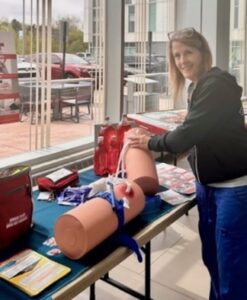 Ann Clancy-Klemme at UP Health System, Marquette hosted multiple awareness tables, including a larger-than-life OPERATIONS game and simulated bleeding control stations to help colleagues fully immerse themselves in the life-saving experience of managing severe bleeding at the scene!
Ann Clancy-Klemme at UP Health System, Marquette hosted multiple awareness tables, including a larger-than-life OPERATIONS game and simulated bleeding control stations to help colleagues fully immerse themselves in the life-saving experience of managing severe bleeding at the scene!
Bring Stop the Bleed to your community: https://mitrauma.org/mtcinjuryprevention/
New Resource for Trauma Centers: Firearm Injury Prevention & Safety Flyer Now Available
As part of its ongoing commitment to injury prevention, the Violence Prevention Committee is excited to share a new public-facing Firearm Injury Prevention & Safety Flyer—designed to support consistent, nonjudgmental messaging around responsible firearm ownership and secure storage.
This flyer was developed in alignment with the American College of Surgeons (ACS) Recommendations on firearm safety and injury prevention, offering a clear, community-focused way to engage patients, families, and the public on this important issue.
What’s Inside the Flyer?
The flyer covers key safety principles, including:
- Secure Firearm Storage – Clear guidance on how to safely store guns and ammunition
- Safe Conversations – Tips for asking about storage before your child visits another home
The language is supportive and accessible, grounded in research and public health best practices. A direct link to mitrauma.org/injury-prevention has been included, making it easy to connect people to more resources.
How Can You Use It?
This flyer is designed to be flexible and co-branded* by your hospital, trauma center, or coalition partners. Here are some potential applications:
- Hospital Lobbies & Emergency Departments
Display near check-in, triage, or family waiting areas
- Community Outreach Events
Share at health fairs, gun lock giveaways, or violence prevention events
- Pediatric or Primary Care Clinics
Include during well-child visits when discussing household safety
- School Safety Nights or PTA Events
A helpful tool when speaking to caregivers about youth risk and prevention
- Digital Use
Embed in newsletters or share on social media with secure storage messaging
We hope this flyer is a valuable tool in your trauma center’s injury prevention work. Let’s continue working together to keep Michigan families safe.
*If a facility logo is added to this or any MTC materials, the information within the flyer cannot be changed and the MTC logo must remain in its current location.
Marie Snodgrass
Injury Prevention Program Lead | C.S. Mott Children’s Hospital | Pediatric Trauma Program
Injury Prevention/Healthcare Representative National Child Passenger Safety Board
Safe Kids Huron Valley Program Coordinator
On April 2nd, Michigan’s new Child Passenger Safety Laws will go into effect. Countless child passenger safety advocates from across the state worked closely with bill sponsor, State Representative Carrie Rheingans and her team, (serving parts of Jackson and Washtenaw Counties) to create House Bills 4511 & 4512. These bills better align with American Academy of Pediatrics child passenger safety recommendations.
HB4511 includes-
- keeping children riding rear-facing until at they are least 2 years old, or they have reached the maximum weight or height limit of the rear-facing child restraint, set by the manufacturer
- keeping children in five-point harnessed car seats until they are at least 5 years old, or they have reached the maximum weight or height limit of the rear-facing child restraint, set by the manufacturer
- keeping children in booster seats, with the vehicle lap-shoulder seat belt, until they are at least 8 years or 4’9” tall
- children who are at least eight years old or at least 4’9” tall, but are under 13 years old, must be restrained with a properly adjusted and fastened safety belt in a rear seat, if the vehicle has a rear seat and not all the rear seats are occupied by children
- Michigan is also what is commonly referred to as a Proper Use state and there is a statement that reads that a child must be secured in a restraint system that is appropriate for the child’s weight and height and configured according to the restraint system manufacturer’s instructions and the vehicle manufacturer’s instructions and standards.
HB4512 amends the previously written code that allows a judge to waive a civil fine or citation for not having a proper child restraint, if the caregiver was able to show proof of acquiring car seat before appearing for the citation. The new law is written so that the caregiver will also have to provide evidence that they received education from a Certified Child Passenger Safety Technician.
These are significant changes to Michigan’s laws that members of Michigan’s Child Passenger Safety community have been advocating for, over many years. The persistence of these advocates paid off as they testified year after year in front of numerous State Legislators for these changes. All involved are excited to have Michigan laws align with what is known to be best practice and the safest way for children to ride on Michigan roads.
View the infographic flyer by the Michigan Office of Highway Safety Planning.
Legislative Advocacy and Outreach Committee
Stop the Bleed Legislation – House Bills 5741, 5742, and 5743 update Michigan’s Good Samaritan Law to cover bleeding control techniques, as well as add education requirements to have 7th-12th graders take a Stop the Bleed course. The bills are currently in the House Judiciary Committee where MTC testified in support of these bills. The next step is to report the bills to the House floor where a vote before all 110 Representatives can take place. We hope to provide an update soon.
MTC Stop the Bleed Subcommittee
Imagine being the school bus driver involved in a bus collision and there is a need to render aid to a child involved in the crash. Or walk in the shoes of a neighbor who just witnessed their friend start to bleed after cutting themselves while trimming a tree. The “helpers” in these situations would be considered “Good Samaritans”- anyone who renders aid in an emergency to an injured or ill person. In some states and countries there are laws put in place to protect the acts of a Good Samaritan. In fact, all 50 states have good Samaritan Laws, with some variations in who is protected and in what circumstances. In some countries, there are Duty to Rescue Laws that hold a person liable if they fail to act in an emergency!
Enter the Stop the Bleed Program…
The American College of Surgeons developed a program, called Stop the Bleed, that teaches non-medical people techniques to control a life-threatening bleed at the scene of an emergency until help arrives. The idea behind the program is to encourage any bystander to help a person who is bleeding to reduce the risk of bleeding to death. The encouragement of such life-saving measures is supported by organizations like the American Association for the Surgery of Trauma, that recently reported that pre-hospital use of tourniquets is not only increasing, but improving the outcomes of civilians with major extremity trauma
So why NOT help?
Many non-medical community members come to the Stop the Bleed Trainings with the question, “What can I do to help if I come across someone that is bleeding”. Often, the question then becomes, “Can the victim or family take legal action if I cause harm while rendering aide using Stop the Bleed techniques?”. The answer if you live in Michigan is… Yes. Currently, only three states that provide protection from liability for a citizen that provides Stop the Bleed measures. Review of the Michigan Good Samaritan Law reveals that protections are provided to:
- Physician, physician’s assistant, nurse, or EMS provider rendering emergency care; determining fitness to engage in competitive sports
- Medical staff who respond to a life-threatening emergency within a hospital or medical center
- An individual who administers an opioid antagonist
- Any individual who administers CPR or uses an AED
- Block parent volunteer renders assistance to a minor during an emergency
- Member of national ski patrol system rendering emergency care
Simply put, Michigan’s Good Samaritan Law does not currently offer protection for someone rescuing a person with a life-threatening bleed by applying a tourniquet or holding pressure.
Michigan’s Legislators are working to amend the Good Samaritan Law to protect people who use Stop the Bleed techniques in rendering emergency aid to someone experiencing a life-threatening bleed.
MTC members, please send an email to your elected officials to support legislation introduced on Stop the Bleed (the Good Samaritan bills).
Madonna Walters, MS, RN – Member, MTC Legislative Advocacy & Outreach Committee
Trauma RN, Henry Ford Jackson Hospital, Jackson, MI
In May of 2019, Michigan Governor Whitmer signed a law that dramatically changed Michigan’s Auto No-Fault insurance. This legislation reversed a no-fault law that had stood since 1973. Today, efforts are underway in the Michigan legislature to restore some of the benefits in place prior to the 2019 reform, due to its unintended consequences and devastating effects on patient’s lives.
At the time of the 2019 signing, a press release from Governor Whitmer’s office lauded the auto no-fault reform as “guaranteeing a better auto insurance system for everyone” by assuring better protection for consumers and lower insurance rates. This sounded too good to be true, and it was. The result was a reimbursement system that cut post-acute and home care reimbursement by 45% for auto crash victims, many catastrophically injured, and gutted their care delivery system. It also created a new Medicare-based fee schedule for hospitals and providers caring for car crash victims. The new law went into effect on June 11, 2019, and created chaos for the seriously injured, including those who were paralyzed, brain-injured, ventilator-dependent, or those who simply required a lot of nursing care and at-home rehab during their recovery. That system of care could simply not survive a 45% pay cut.
When the payment reductions went into effect in July 2021, insurance companies quickly interpreted the cuts as applying to incumbent victims as well as those injured after June 11, 2019, when the law itself went into effect. It took a 5-2 decision from the Michigan Supreme Court to rule that the changes in reimbursement did not apply to the 17,000 to 18,000 people injured before the auto no-fault legislation of 2019. For some, this was too late. Take, for example, the case of Brian Woodward, a paralyzed man of 64, who died after a merry-go-round of care shuffling him between nursing homes and multiple acute care hospitals. Prior to the 2019 reform, he had been cared for at home. According to reporting by Chad Livengood of the Detroit News, Woodward died just 90 minutes before the court restored care for those injured before June 11, 2019.
But even after the high court ruling, the health care system designed to care for trauma victims is in a tailspin. Many home care agencies have already shut down or they are no longer taking on new car crash victims. Their business model cannot sustain a 45% reduction in funding for the daily care of victims of catastrophic accidents. Nor is the model tenable for the care they receive during their hospital stays and visits to the emergency room when problems occur.
The crisis at the agency level has left many patients with no one to care for them. In some cases, like 5-year-old quadriplegic Annabelle Marsh, whose story was also reported by Chad Livengood, agencies have continued to provide care at the lower rate, in spite of losing money every month. Family members have stepped in when they could and many have gone bankrupt, leaving their injured family members moved to Medicaid-funded nursing homes. For the catastrophically injured, this has meant many trips back to the emergency department and in some cases, an early death.
Now we have an opportunity to make these models viable. Michigan Senate Bills 530 and 531 would do that. On one hand, they would improve reimbursement rates for post-acute home care, reversing the 45% cuts made in 2019. Victims of catastrophic crash injuries would see improved access to the consistent, high-quality care that they require. On the other hand, the proposed legislation includes increases in the reimbursements to hospitals. With an inadequate funding model, they are straining under the cost of caring for these post-acute patients when health issues arise. Under the proposed legislation, a new non-Medicare fee schedule with fair rates would allow the level of care that everyone expects.
These bills have already passed in the Michigan Senate, prior to the December recess, thanks to 20 Democrats and 4 Republicans. Now we need your help to get these bills through the Michigan House and to the Governor’s desk. Please contact your Michigan Representative as well as the Governor to voice your support for these two bills. Here is a link to a sample letter that you can send to them or paste into a message on their website. This is time-sensitive, as the Michigan Legislature will be back in session in January 2024. If you don’t know the name of your Michigan Representative, use this BallotPedia site to help find them.
Note that while a majority of the Michigan Senate agreed that payment rates to post-acute providers needed to be increased to ensure adequate care for car crash survivors, the bills face an uphill battle with the House and Governor. As reported in Crain’s Detroit Business, the Governor’s office and the Department of Insurance and Financial Services opposed the legislation and have called for a “narrower solution.” A narrower solution may be to cut hospitals out of the deal and focus only on increasing home care and post-acute care.
Laura Walker, RN, BSN, EMT, CFRN
Trauma Education and Outreach Injury Prevention Specialist
Covenant Healthcare – Saginaw, MI
Keeping pedestrians safe is one of the missions of the Michigan Office of Highway Safety Planning (OHSP). According to the OHSP, Michigan saw a 17% rise in pedestrian fatalities in the three-year period from 2020 to 2022. During that time, a total of 531 pedestrians were killed on Michigan roadways.
During 2022 alone, there were 2026 motor vehicle crashes involving pedestrians, and in those, 1566 people were injured and 173 were killed. The OHSP further notes that 86% of pedestrians involved in crashes were either injured or killed.
To raise awareness about the issue of pedestrian injuries and fatalities, the OHSP promotes National Pedestrian Safety Month beginning October 1st.
To help keep everyone safe, drivers and pedestrians are encouraged to follow these safety tips:
- Pedestrians should always cross at crosswalks.
- Wear reflective clothing, especially from dusk to dawn.
- Utilize sidewalks when available.
- If using the road, walk facing traffic and stay far to the left.
- Drivers must yield to pedestrians in crosswalks, intersections, and all traffic-controlled areas. The best practice for drivers is to always yield to pedestrians.
For more information about pedestrian safety, see the Michigan State Police Pedestrian Safety site.
Holly Alway, MTSA – Injury Prevention
Trinity Health Muskegon
Before dropping your child off at a new friend’s house, you probably ask the adult in charge about allergies, pets, diet restrictions, supervision, internet access, and more. To keep these home visits safer and fun, ask one more important question: “My kid is pretty curious, and our doctor recommended that I ask: if you have guns, do you keep them locked up?”
Even if a firearm is stored out of sight, children are not out of danger if it isn’t stored safely. One out of every three homes with children has a gun, and even if you think they don’t know where it is, studies show that children as young as five years old know where to find it. According to HealthyChildren.org, more than a third of unintentional shootings of children happen in other people’s homes, so asking about firearms is critical.
Many parents and caregivers understand the consequences of this issue but are unsure of how to start the conversation with other adults in charge. To help families navigate these conversations, pediatricians and child safety advocates across the United States have beenusing the ASK (Asking Saves Kids) initiative as a guide. In honor of ASK Day on June 21st, the Michigan Trauma Coalition (MTC) is encouraging parents and caregivers to ask about unlocked firearms in the homes their children visit.
Protect your child by knowing the environment you’re sending them into. With a few minutes of preparation ahead of time, create a plan of action by using the following tips:
- Learn about safer storage and why it’s important from HealthyChildren.org.
- Prepare your script.
- Decide who to ask, how to ask, and how to respond to different answers.
- Figure out who you’re most comfortable talking to among the adults in charge, and ask your questions before the visit.
- The conversation can be held face-to-face, on the phone, or over text message.
- Talk to your children. Teach children not to touch guns and find an adult right away if they find one.
Laura Walker, BSN, RN, EMT, CFRN – Trauma Education Injury Prevention Outreach Specialist – Covenant HealthCare, Saginaw, MI
On May 25, 2023 the Michigan Trauma Coalition (MTC) and the Michigan Committee on Trauma (MCOT) held a Stop the Bleed Legislative Advocacy Day at the Michigan State Capitol. This is the third time they have partnered to provide this event.
Eighty volunteers from MTC and MCOT, as well as nursing students and medical students, dressed in red Stop the Bleed t-shirts to identify themselves as trainers. Throughout the day they trained legislators, staff, and visitors. The red-shirted trainers taught participants how to recognize life-threatening bleeding, how to pack a wound, and how to apply a tourniquet.
At their demonstration tables, Stop the Bleed volunteers gave away 377 first aid kits to attendees. The first aid kits contained Stop the Bleed instructions along with the usual bandages, gloves, and supplies. MTC and MCOT also donated some of the first aid kits to Capitol Security, who provide ongoing training to new staff.
Though 55 people were trained, it’s hard to estimate the total impact of the event, as numerous other people stopped by the demonstration tables, including both staff and visitors. MTC and MCOT are proud of their volunteers and their efforts to educate and bring awareness to both the Capitol attendees and by extension, their greater communities.
For more information about the Stop the Bleed program, visit the national Stop the Bleed website.
On June 7, 2023, Governor Gretchen Whitmer joined state officials and anti-distracted driving leaders to sign three bills aimed at reducing distracted driving and saving lives by ensuring that drivers have their full attention on the road with the use of hands-free technology.
“I’m proud to sign today’s legislation to reduce distracted driving in Michigan. Too many Michiganders have lost loved ones to distracted driving, and everyone should be safe on their way to school, home, or work,” said Governor Whitmer. “We developed our last Strategic Highway Safety Plan in 2019 and already we have seen a reduction in the number of fatalities caused by distracted driving. These bills are another step toward reducing that number even further. Our goal is to see zero traffic deaths by 2050 and I know that by working together we can get it done.”
“We are working to ensure Michigan roads are safe for everyone. This important new law updates the rules of the road to reflect today’s reality and to protect drivers and passengers, cyclists and pedestrians,” said Secretary of State Jocelyn Benson. “I’m grateful to Governor Whitmer and lawmakers on both sides of the aisle for taking this important step to reduce distracted driving and save lives on Michigan’s roads.”
The Governor’s Traffic Safety Advisory Commission (GTSAC) was formed by an executive order in 2002 to identify traffic safety challenges and champion strategies to address them. The GTSAC develops regular Strategic Highway Safety Plans to eliminate fatalities and serious injuries on our roadways. The Commission developed the last plan in 2019 with a focus on distracted driving and by working together, Michigan’s traffic safety partners have been able to reduce distracted driver fatalities by six percent and reduce fatalities involving drivers under 21 by eight percent.
Governor Whitmer signed House Bills 4250, 4251, and 4252 which were sponsored by state Representatives Matt Koleszar, Tyrone Carter, and Mike Mueller. In the Senate, state Senator Paul Wojno sponsored companion Senate Bills 239 and 240 and state Senator Kevin Hertel sponsored Senate Bill 241.
House Bill 4250 updates Michigan’s distracted driving laws, which currently includes texting and driving, to also include watching or recording videos and engaging in social media, among other usages. The new law would allow drivers to take advantage of new voice-operated or hands-free technology if they need to use cell phone functions. The bill also allows a court to order drivers to complete a basic driver improvement course if they are found responsible for three or more civil infractions within a three-year period and updates fines for infractions.
“Passing this bi-partisan legislation will have a positive impact on helping make our roadways safer for all users by reducing distractions while driving,” said state Senator Paul Wojno (D-Warren). “Staying focused and not driving while distracted will help reduce accidents and save lives.”
“Dangerous incidents tied to distracted driving have continued to increase and it is clear that our state’s motor vehicle laws are in desperate need of modernization. The signing of these bills into law marks the end of five years’ worth of bipartisan work,” said House Bill 4250 sponsor state Representative Matt Koleszar (D-Plymouth). “This legislation is designed to make our roads safer for every driver and passenger in Michigan and provide law enforcement with the tools they need to crack down on this dangerous behavior.”
House Bill 4251 provides accountability for drivers who put themselves and others in danger by making related changes regarding commercial vehicles, driving record points, and driver improvement courses.
“Too many of us have seen first-hand the harmful consequences and damage caused because people were not fully paying attention to the road while behind the wheel,” said House Bill 4251 sponsor state Representative Tyrone Carter (D-Detroit). “Current Michigan law doesn’t go far enough to protect drivers on the road, and this legislation is changing that. Simply banning texting is not enough with evolving technology and the convenience of smartphones. I’m grateful to have been a part of ensuring these bills made it to the Governor today. In order to increase public safety, we must ensure that people remain alert and focused while they are behind the wheel.”
House Bill 4252 requires the Michigan State Police (MSP) to submit a progress report on the effectiveness of the new law 3.5 years after it takes effect. After introducing a hands-free law in April, Ohio has seen a nine percent drop in distracted driving in just one month, preventing over 500 crashes.
“Too many Michiganders have been injured or lost their lives because of a distracted driver,” said state Senator Kevin Hertel (D-St.Clair Shores). “As a father and a regular commuter, I am grateful to see this legislation pass and ready to get to work on educating our public that keeping eyes on the road- and off our phones-helps make everyone’s travel safer.”
“This legislation is about changing the culture for our young drivers and saving lives,” said House Bill 4252 sponsor state Representative Mike Mueller (R-Linden). With progressing technology, the new law will reenforce good driving practices, which will ultimately lead to safer roads for all drivers. Other states that have enacted these policies have seen proven drops in vehicle collision fatalities.”
Statements from officials and community leaders:
“I am so pleased and honored to be with Governor Whitmer and other victims’ families today, as these life-saving bills are signed into law. It is especially moving for me and my family to have these bills signed at the Mitchel Kiefer Memorial Ice Rink, where Mitchel played his last hockey game with Detroit Catholic Central,” said Steve Kiefer, Founder and Chairman, Kiefer Foundation. “With this legislation, Michigan becomes the 26th “Hands Free” state in the nation, making it illegal to hold an electronic device while driving, and The Kiefer Foundation will not stop until all 50 states have similar legislation in place. Based on the results in other states, we know that these laws will save lives in Michigan this summer – I am certain that Mitchel is with us today, smiling, as we change the world in his honor.”
“As someone who spent much of my career in construction and overseeing the design of roads, this especially resonates with me,” said Brad Wieferich, director of the Michigan Department of Transportation. “Everything we do is informed by the imperative to build and maintain a safe system for the traveling public. Reducing distractions for drivers will provide further protections to motorists and the people working on our roads.”
“As manufacturers and automakers, we take our roles extremely seriously when it comes to answering the challenges that arise when we combine busy people and new tech. And today, as always, our roles are to be the problem solvers, the engineers and the innovators that put our expertise to work to invent a set of new solutions – And to adapt our business model to ensure that what might be cutting-edge today can be implemented tomorrow across the board, as a standard feature on all future vehicles, accessible to everyone who drives any of our cars off the lot,” said Lisa Lunsford, Chair of MICHauto and CEO & Co-Founder of Global Strategic Supply Solutions. “Just as we lead our industry from Michigan in placing better, safer and smarter technology within reach of the driver’s seat, we hope that bills like these will continue to be enacted across the country.”
“The 15,000 members of Operating Engineers 324 are the central to the skilled workforce that carry out the critical work of fixing and repairing roads and bridges of our state,” said Operating Engineers 324 Business Manager Douglas Stockwell. “This work often takes place just inches from moving traffic, and too often we have seen the tragedies that occur when motorists choose to look at their phones rather than the road in front of them. We need to do everything in our power to make sure road work can be done safely, and this bill to eliminate distracted driving does just that – makes work zones safer and helps ensure that those working and driving on Michigan roads return home safe at the end of the day.”
Kandace Novotny, Hospital Donation Advocate
Gift of Life Michigan
National Donate Life Month (NDLM) is observed in April each year to help raise awareness about donation, encourage Americans to register as organ, eye, and tissue donors, and to honor those who have saved lives through the gift of donation.
This NDLM, you can be a part of this interconnected life-sustaining community by championing the Donate Life cause, becoming educated about living donation, and by registering as a donor. You can register at the Michigan Organ Donor Registry website or through your local Michigan Secretary of State office. (The Secretary of State option is available when you renew or replace your driver’s license or state ID card at the Secretary of State office or through Michigan’s online services.) Once you enroll, you will receive a heart sticker for your driver’s license or state identification card, designating your decision to be an organ and tissue donor.
 Michigan residents can Check Your Heart by looking at your Michigan driver’s license or state ID to be sure you are registered. If not, it takes just 5 minutes or less to add your name to the Michigan Organ Donor Registry.
Michigan residents can Check Your Heart by looking at your Michigan driver’s license or state ID to be sure you are registered. If not, it takes just 5 minutes or less to add your name to the Michigan Organ Donor Registry.
But not everyone knows how to do this, so Gift of Life Michigan is looking for hospitals, employers, schools, and community groups willing to provide easy access by emailing their teams the Check Your Heart link or QR code to sign up.
WHY IT MATTERS
While 90% of adults approve of donation, only 56% of Michigan adults have documented their decision by registering. When residents fail to sign up, they leave their families with the burden of making a decision, and in that situation just 44% say yes on behalf of their loved one. That means opportunities to save lives are lost. There’s urgency today as 2,400 patients in Michigan wait for a lifesaving organ transplant. Eighty percent of them need a kidney.
In addition to the Check Your Heart campaign, there are several days of celebration throughout April:
- Donate Life Living Donor Day is April 5, 2023.
- Blue & Green Spirit Week starts April 8, 2023.
- National Donate Life Blue & Green Day is Friday, April 14, 2023.
- National Pediatric Transplant Week is April 23-29, 2023.
Questions? You can learn more about organ and tissue donation at the Gift of Life Michigan FAQs page.
Celebrating the generosity of donors and the lives they save
Each April, Donate Life America (DLA) leads National Donate Life Month (NDLM), an observance to focus national attention on the need and importance of organ, eye and tissue donation. National Donate Life Month is about the importance of registering your decision to be a donor, and honoring deceased and living donors — recognizing that the generosity of donors makes saving lives through transplantation possible.
Donate LifeTM is the national brand for the cause of donation, uniting the hundreds of donation and transplantation organizations; the hundreds of thousands of recipients, living donors, donor families, supporters and patients waiting; and the 170 million people who have registered their decision to be a donor at the end of their life.
More than 100,000 people across the country are currently waiting for a lifesaving organ transplant. Thousands more people are waiting for lifesaving and healing cornea and tissue transplants. Because only 3 in 1000 people die in a way that allows for organ donation to take place, it is vitally important for everyone to register their lifesaving decision to be an organ, eye and tissue donor. Learning more about and considering living donation is another way to help those waiting for a second chance at life.
Ways to participate in National Donate Life Month 2022:
Give hope and help save lives by registering your decision to be an organ, eye and tissue donor at Gift of Life Michigan GOLM.org, on RegisterMe.org or in the Medical ID tab of your iPhone Health app. To those who have already registered their donation decision, thank you! Help continue to save lives by sharing the Donate Life message, educating others about the need and how their generosity can help save and heal lives.
The 2022 National Donate Life Month Artwork was inspired by the vital role that bees play in sustaining life. Bees are a small but powerful life force, working together with dedication, collaboration and a strong sense of community. NDLM art is used in resources and events throughout April.
You can join key celebrations throughout April to support the Donate Life cause online and in your community:
- Blue & Green Spirit Week, April 16-22, 2022
Each day of the week leading up to National Donate Life Blue & Green Day is dedicated to a special theme. Information and free public resources are available at DonateLife.net/celebrations. - National Donate Life Blue & Green Day, April 22, 2022
On Donate Life Blue & Green Day, we invite everyone to show their blue & green colors in support of the Donate Life message and mission. DLA hosts an annual National Donate Life Blue & Green Day Photo Contest at DonateLife.net/blue-green-day/. The photo contest is open to the public, and each year photos are submitted showcasing incredible blue and green spirit and creativity.
- National Pediatric Transplant Week, April 24-30, 2022
The last full week of National Donate Life Month is dedicated to kids. National Pediatric Transplant Week (NPTW) focuses on ending the pediatric transplant waiting list. Information and free public resources are available at DonateLife.net/pediatric-transplant-week.
Thank you to the United Network for Organ Sharing (UNOS), the American Society of Transplantation (AST), the American Society of Transplant Surgeons (ASTS), the International Transplant Nurses Society (ITNS) and Transplant Families for their partnership in helping develop and grow this important week
*Data from the Donate Life America (DLA) Registry Overview Report, organdonor.gov, and Organ Procurement and Transplantation Network (OPTN) as of March 2022
Anita Barksdale, BSN, RN, CPST
Injury Prevention, Community Education, and Outreach Coordinator
Trinity Health Oakland
Over a two-month period from February 2022 to March 2022, the Trauma Program of St. Joseph Mercy Oakland in Pontiac took on a daunting but rewarding task. They teamed up with Clarkston Community Schools and other member hospitals from the Michigan Trauma Coalition to provide STOP THE BLEED® education to over 1100 teachers and staff. Together with Trauma and Injury Prevention Experts from Henry Ford Health System, the Detroit Medical Center, Covenant Health, McLaren Health, Hurley Medical Center, and Beaumont Health, they provided 14 highly engaging training sessions to seven elementary schools (K-5), one middle school (Gr 6-7), one junior high school (Gr 8-9), Clarkston High School (Gr 10-12), Renaissance High School (the district’s alternative high school, Gr 9-12), the Early Childhood Center, Transportation Staff, and Operations and Maintenance crews. It’s the kind of hands-on training that teachers and staff hope they’ll never have to use. Clarkston Community Schools is invested in the safety of their staff and students, and they offered the STOP THE BLEED® Training in conjunction with their annual “ALICE” active shooter response training (aka “Alert/Lockdown/Inform/Counter/Evacuate”).
For more information, see the Channel 4 Detroit report.
Val Canary, CPNP – Hurley Medical Center, Flint, Michigan
What is House Bill (HB) 5094?
HB 5094 has been introduced into Michigan’s House of Representatives and provides for continued funding of Michigan’s Trauma System for another 3 years. Currently the system is set to have funding cut in ½ beginning October 1, 2021. On September 14, 2021, the bill was read in the House of Representatives. That same day the Michigan Coalition to End Domestic Violence shared a letter with legislators in opposition of the bill. Without enough affirmation of support, it appeared we did not have the votes to pass the bill and was thus it was tabled. The Michigan Trauma Coalition has been rallying since this time and we are once again anticipating a vote on Tuesday September 21, 2021. Hence, I reach out to you once more to voice your support for this critical legislation.
Why is HB 5094 important?
By extending full funding of the statewide trauma system Michigan can continue efforts to create a cohesive, efficient, and interconnected system of care for trauma patients. This means patients will be transferred more expeditiously to definitive care and patients will receive necessary care regardless of the location where injury occurred.
What can I do to help pass this legislation?
To help pass this vital legislation MTC is asking members to once again reach out to legislators to request their support to pass House Bill 5094. A link to an editable letter for legislators is below. Please feel free to utilize the editable letter and personalize by including a story that speaks to the importance of the statewide trauma system. Also, if you have a hospital lobbyist, we encourage you to reach out to administration to request their support to pass this essential legislation. All voices from the MTC must be heard to pass this legislation. If you reached out before 09/14/21, I urge you to contact your legislators once more to let them know this bill must pass.
Legislative Matters/Advocacy | Michigan Trauma Coalition (mitrauma.org)
Thank you in advance for your efforts to pass HB 5094.
From Michigan’s Region 1 Trauma Network
Why is there a blood shortage at this time?
Trauma centers in Michigan, and across the U.S., are currently facing a severe blood shortage due to an unprecedented number of blood drive cancellations in response to the coronavirus outbreak. Healthy individuals are needed now to donate and to help patients counting on lifesaving blood.
As the coronavirus pandemic escalated here in the U.S., blood drive cancellations also grew at an alarming rate. Blood centers in Michigan – including the American Red Cross, the Versiti Blood Center of Michigan, and the Upper Peninsula Regional Blood Center (UPRBC) – have issued urgent calls for blood donors to help relieve the blood supply emergency. The blood shortage is so dire it could mean a crisis for Michigan communities if unrelieved.
How great is the need for donated blood in Michigan right now?
According to Todd Kulman, spokesman for Michigan’s Red Cross Chapter, the Red Cross needs to collect about 700 blood donations a day to keep hospitals stocked. The Versiti Blood Center of Michigan needs about 560 blood donations a day, according to Zachary Warren, Communications Specialist for Versiti.
To date, nearly, 2,700 Red Cross blood drives have been canceled across the country due to concerns about congregating at workplaces, college campuses and schools amidst the coronavirus outbreak. These cancellations have resulted in some 86,000 fewer blood donations. More than 80 percent of the blood the Red Cross collects comes from drives held at these locations.
Versiti also reports donations are down more than 40 percent in the first quarter alone, compared to a typical year. This is a reduction of nearly 20,000 units of blood. “As more people are getting vaccinated and getting out of their homes, attention has shifted away from blood donation,” said Dr. Dan Waxman, vice president of transfusion medicine and senior medical director at Versiti. “On top of that, drives at schools and businesses, which are typically Versiti’s largest source of blood donations this time of year, have been canceled. All of this is creating a crisis situation – a shortage of much-needed blood.”
In the upper peninsula, the UPRBC is currently experiencing a critical need for O Negative, B Negative, A Negative, A Positive, and AB Positive blood types. “This blood shortage impacts 13 U.P. hospitals and the safety of patients,” the Facebook post from the UPRBC reads. “Healthy, eligible donors are needed now to donate to help patients counting on lifesaving blood.”
How and why does the blood shortage affect trauma centers?
Right now, hospitals are responding to an atypically high number of trauma cases and emergency room visits. In comparison to 2019, the Red Cross reported that red cell demand from hospitals with trauma centers climbed by 10 percent in 2021 – more than five times the growth of other facilities that provide transfusions. Twenty to 40 percent of trauma deaths that occur after hospital admission involve massive hemorrhaging. In these dire circumstances, doctors may need hundreds of blood products to help save a life, depending on the severity of traumatic injuries.
Where and when can you donate blood?
You can donate blood either through a regional blood donation center (where they typically post scheduled hours and make appointments), or through a local mobile drive. You can also search for a donation event by zip code or in a city near you:
Michiganders are urged to avoid being discouraged by wait times or the lack of immediate appointments.
_________________________
Click HERE to view letter from MTC to Michigan Legislators re: blood shortage.
This article available as a downloadable PDF
Val Canary, CPNP
President of Michigan Trauma Coalition and Pediatric Trauma Program Manager
Hurley Medical Center, Flint, Michigan
May is Trauma Awareness month! What better time to recognize all our Michigan Trauma Coalition members and trauma professionals for their relentless efforts to reduce injuries and provide optimal care through a statewide trauma system.
You make a difference every day in the lives of Michigan residents. This month we honor you as we celebrate the contributions of trauma professional staff. Most importantly, we thank you for your service to others as we celebrate Trauma Registry Professionals Day, National Nurses Day, Trauma Injury Prevention Professionals Day, National EMS Recognition Day, and Firefighter Appreciation Day. Thank you all for holding steadfast during the pandemic and for answering the call during this last year. Michigan Trauma Coalition is proud of all trauma professionals and the work they do to improve the care of Michigan’s trauma patients.
Please review the dates below for specific observances during this month and take a moment to thank colleagues and yourself for all you do to improve the care of the trauma patients in our state.
- May 4th Firefighter Appreciation Day
- May 5th Trauma Registry Professionals Day
- May 6th National Nurses Day
- May 12th Trauma Injury Prevention Professionals Day
- May 21st National EMS Recognition Day
It takes a village of professionals working together as we rise to meet the needs of patients and our communities. Thank you for lending your unique talents to our trauma village and for all you do.
With Sincere Thanks,
The Michigan Trauma Coalition
Nicole Matthews, RN
Injury Prevention Coordinator Safe Kids Greater Flint
Hurley Medical Center – Flint, Michigan
Violence. What does it mean to you? This topic profoundly resonates with me as a survivor of being held at gunpoint once and held at knifepoint twice in my life. Violence prevention is a deeply held passion, and Injury Prevention professionals often state, “If we can predict it, we can prevent it.” Overall, rates of violence are rising, and this impacts us all. According to statewide data in Michigan specifically, we have experienced a 26% increase in penetrating trauma when comparing the first nine months of 2019 to 2020.1 The Trauma Recovery Center (TRC) has also seen a dramatic rise in traumatic violence rates, according to its Director, Tia Coles. The TRC is a center dedicated to assisting victims of traumatic violence.
Data
The pandemic has driven many trauma leaders to study the increasing rates of interpersonal violence and violence-related hospital admissions. Trauma program staff have wondered aloud whether these anecdotal reports were hyperbole or evidence of an alarming trend. Several research articles confirm the increase in penetrating trauma and violent intentional injury in general. In a retrospective review by Abdallah et al. published in the Journal of the American College of Surgeons in February of 2021, the authors noted an increase in intentional injury at a Philadelphia trauma center from 19.6 percent to 30.8 percent (p=0.0002) following stay-at-home orders (SAHO) instituted there in 2020. In absolute numbers, this was an increase in unintentional injuries to total injuries from 70/357 to 148/480.
During the same period, the rate of isolated gun-shot wounds increased from 12.6 percent to 22.9 percent (p=0.001). These increases occurred while the overall proportion for unintentional trauma reduced from 80.4 percent to 69.2 percent (p=0.0002). They concluded that either factor around the pandemic or the SAHOs – or both – had augmented existing urban violence.
The American College of Surgeons Committee on Trauma (ACS-COT) also completed a retrospective study with authors Chodos et al. They conducted a multi-center study of all adult trauma centers in the Washington, DC area from January 2019 through May 2020, separating the data into comparisons of ‘pre-COVID’ and ‘during-COVID.’ They found that penetrating trauma increased during COVID as compared to pre-COVID, 22.6 percent vs. 15.1 percent (p<.001). In absolute numbers, there was “a large, positively correlated trend” in the actual incidence of penetrating trauma during the study period.
Firearms and stabbing injuries increased 11.8 percent from 6.8 percent (p,0.001) and 9.2 percent from 6.9 percent (p=0.002), respectively. During this same period, blunt trauma decreased proportionally, from 84.9 percent to 77.4 percent. The authors recommended that future planning for pandemics must include “planning for an increase in trauma center resource utilization from penetrating trauma.”
According to Corinne Peek-Asa, rural populations are not immune to pandemic effects, director of the University of Iowa Injury Prevention Research Center (UI-IPRC). states that the risk factors for injuries and violence during a pandemic “may be disproportionately increased in rural populations.” As the UI-PRC noted in a recent post, social distancing and SAHOs, although critical to dealing with the pandemic, are in turn associated with increases in social isolation, intimate partner violence, injuries to children, and suicide in rural areas. When there is no pandemic, there are fewer healthcare services and shelters in rural communities, and suicide rates are higher in the rural U.S. at baseline.
Considerations
Where does this lead us? The current pandemic continues to prohibit direct-contact injury prevention events in many areas making prevention efforts difficult. However, there are things that we can do. First, we can be patient and display kindness toward others in our communities. We can also consider blood donation. As penetrating trauma increases, there is likely an increased need for blood donors. Please enter your zip code here for an American Red Cross blood donation site near you, and give today. Lastly, we can support our in-state trauma centers caring for victims of violence.
We know there is a 25 percent higher survival rate for injured patients treated at trauma centers versus those seen in hospitals without trauma services (MacKenzie et al., NEJM, 2006). Also, we know that a high cost is associated with these preventable injuries; According to the Coalition for National Trauma Research (CNTR), even a 5 percent reduction in trauma deaths and the economic burden would save 10,000 lives and $33 billion dollars each year.
In the words of Tia Coles, Hurley Medical’s Trauma Recovery Center, “We’ll never know if we overreacted or did too much – but we know when we have not done enough.” The very least we can do is to support a fully funded trauma system in Michigan to care for the most life-threatening injuries in our communities and be mindful of these impactful trends.
References
- Michigan Trauma Data information is provided on an “as is” basis. All warranties of any kind whatsoever are disclaimed. ImageTrend™ Patient Registry accessed on 3/1/21 meeting NTDB inclusion criteria. Incidents are missing if they do not have all the fields required to ascertain inclusion.
Laura Walker, RN, BSN, EMT, CFRN
Trauma Education and Outreach Injury Prevention Specialist
Covenant Healthcare – Saginaw, Michigan
National STOP THE BLEED® Day project and National Scholarship Program is proud to offer Frontline Families Scholarships for high school students of frontline workers including food supply chain workers, nurses, firefighters, EMS/EMT, police, teachers, paramedics, and others. All applications must be received by May 8,2021. Winners will receive financial scholarship as well as Stop the Bleed kits for their schools. For more information, please visit https://nationalstopthebleedday.org/scholarship-program/
This article is also available as a downloadable PDF file.
Laura Walker, RN, BSN, EMT, CFRN
Trauma Education and Outreach Injury Prevention Specialist
Covenant Healthcare – Saginaw, Michigan
Suicide. Say the word out loud. What feelings/thoughts do you get when you say the word? Anger, sadness, disbelief, hopelessness? Suicide rates in Michigan have been on a steady rise since 2014. It is the 2nd leading cause of death for people ages 10-24 years. In 2017, Michigan’s mortality rates exceeded the national average. COVID has not slowed down the rate or incidence of suicide attempts.
Public Health officials have recognized this as a major concern. In 2019 the Michigan Senate passed Bill 228 (Public Act 177 of 2019) which developed a commission on suicide prevention. The commission has been working with State departments, agencies, and non-profit organizations to identify causes and underlying factors. The group has four subcommittees: Policy, Data, Workforce and Special Populations. The commission is working to identify the most high-risk populations by looking at factors such as: Age, Race, Rural versus Urban, Occupation and Socioeconomic Status. Once identified, the commission will work on identifying ways to reduce the risk factors and compile a list of evidence-based programs for suicide prevention to help decrease suicide. They will also investigate postvention care, or what care and resources are needed after a suicide has occurred for the family and community.
What can you do to help prevent suicide? It starts with becoming more aware.
Did you know that death by suicide claims more people each year than war and murder combined? Take Five to Save a Life is a suicide prevention program from the National Council for Suicide Prevention.
Five simple actions can save a life:
(1) Learn the warning signs
(2) Know how to help
(3) Practice self-care
(4) Reach out for help
(5) Spread awareness
We can all make a difference! Please visit the Suicide Prevention Resource Center for more information.
Laura Walker, RN, BSN, EMT, CFRN is the Trauma Education and Outreach Injury Prevention Specialist at Covenant Healthcare in Saginaw, Michigan. She has been a nurse for 25 years with experience in the Emergency Department, Critical Care and Flight Nursing. Two and a half years ago she decided to expand her horizons and provide trauma education and injury prevention in the community. She enjoys working with community groups, forming new relationships, and bridging the gaps to make our community a safer place.
Resources
This article is also available as a downloadable PDF file.
Bethany Folsom, MS CCLS, CPST
Pediatric Trauma Injury Prevention Health Educator
C.S. Mott Children’s Hospital – Ann Arbor, Michigan
School is back in session, the weather is getting cooler, and the Halloween merchandise has hit the stores. This means that hopefully trick-or-treating is just around the corner and it’s a good time for a refresher on ways to keep kids safe this Halloween season.
Looking Good While Being Safe
- In years past one of the biggest safety tips shared was to avoid full face masks and to consider using face paint instead. Costume masks that cover the face can limit vision and those that go over the head can affect hearing as well as vision. This year, wear a mask – a face mask that is! Be creative: find ways to incorporate a protective face mask into costumes, and continue to avoid the costume masks that can cause problems.
- Try on costumes ahead of time and make sure that they fit appropriately. Costumes that are too long can be a tripping hazard. Practice walking and allow for good range of motion. Take a look at the quantity of costume items. Kids should have at least one hand free of costume accessories.
- Make sure that kids are visible while trick-or-treating. It gets dark earlier in the evening, often during trick-or-treat times. Look for ways to add reflective strips/tape, glow in the dark items, or even lights into costumes. Trick-or-treaters can also carry flashlights to help see and be seen.
Walk This Way
- Halloween is one of the busiest nights of the year for pedestrians as trick-or-treating is fun for all ages. Practice safe walking habits such as staying out of the street and using the sidewalks. While it could be tempting to cross the street back and forth to get to more houses, drivers may not be able to spot people who are unexpectedly in the street. While on the sidewalk, keep an eye out for cars that are pulling in or out of driveways and alleys.
- Use the crosswalks at intersecting streets to get to the other side. Often intersections have stop signs where drivers should be stopping, but even if there is not, drivers should be watching for pedestrians. Even though vehicles should stop at crosswalks or for pedestrians, don’t assume that they will. Pause before crossing, look for moving vehicles to the left, to the right, and to the left again. Walk across the street while continuing to keep an eye out for cars, and make eye contact with drivers when possible.
- Pay attention while out and about. Put cell phones down and watch out for obstacles and potential dangers along the way.
Fun With Friends
- Kids under the age of 13 should trick or treat with a responsible adult who is actively supervising. As kids get older they will often want to go with friends. Communication between teenagers and caregivers is key: set up a plan including who teenagers are going with, where they will be going and what time they will be home.
- Stay in familiar neighborhoods and areas that are well-lit. Visit houses with the lights on, but stop at the porch: never enter a home.
Sweet Treats
- Inspect candy after arriving at home. Only keep and eat treats that are familiar to you and that are sealed in the original wrapper. Discard any suspicious looking candy, or treats that are not in original wrappers.
- Set up a guideline of when and how much candy children should eat.
Safe Driving During Prime Time
- If possible, avoid driving during trick-or-treating hours. If driving is necessary, proceed with extra caution: drive slowly and watch for children who may dart into or across the street mid-block. Before exiting/entering a driveway or moving through an intersection, check for pedestrians in all directions. As it gets darker, they may be more difficult to spot.
- When driving kids to different houses, streets, or neighborhoods, make sure that they are buckled up. Vehicles should come to a complete stop before kids unbuckle, open the door, and hop out.
- Teach teenagers who need to drive during trick-or-treating hours about the importance of driving slowly and safely. Remind them keep alert, avoid distractions, and pay attention to the road, checking for pedestrians as they navigate through neighborhoods.
Bethany Folsom, MS, CCLS, CPST is a Health Educator with C.S. Mott Children’s Hospital through their Pediatric Trauma Injury Prevention Program. She is especially interested in medication safety, bicycle safety, and pedestrian safety and instructs people of all ages in the importance of injury prevention concepts.
Karla Klas BSN, RN, CCRP – Injury Prevention and Community Outreach Director
Michigan Medicine – University of Michigan Trauma Burn Center, Ann Arbor
National Fire Prevention Week (October 4 – 10, 2020) is less than 3 weeks away! This year’s theme, “Serve Up Fire Safety in the Kitchen” is especially timely with more people cooking at home due to COVID-19. Did you know that cooking is the #1 cause of home fires and related injuries?
Think you don’t have the time or resources to participate? There are numerous free and creative tools that are ready to use (including virtual and physical distancing resources!) in your local communities.
Watch this great webinar that highlights the “out of the box” materials, tools, and creative ideas that you can use. Some of the suggestions are great to apply to other injury prevention topics too!
https://www.nfpa.org/Public-Education
Direct link for webinar:
https://players.brightcove.net/1640544031001/default_default/index.html?videoId=6178462866001
Karla Klas, BSN, RN, CCRP is the Director of Injury Prevention and Community Outreach for Michigan Medicine – University of Michigan Trauma Burn Center. She provides many years of expertise in burn and trauma critical care and is a celebrated educator, speaker and author.
Brooke Jamison RN, BSN
Performance Improvement and Injury Prevention Coordinator
McLaren Macomb Hospital – Mt. Clemens, MI
Each year millions of people, age 65 and up, fall. According to the Center for Disease Control and Prevention, one out of five falls causes serious injury such as a broken bone or head injury. In 2014, Michigan residents spent 1.5 billion dollars treating injuries sustained from falls.
Luckily, suffering from a fall does not have to be an inevitable part of the aging process, explains Registered Nurse Brooke Jamison, the Injury Prevention Coordinator at McLaren Macomb Hospital. Knowing and understanding the reasons for falls can lower your risk. Below are some steps you can take to reduce your risk of falling:
Complete a home safety checklist. Do a walk-through of your home and address some of the most common causes of falls:
- Keep walkways free of clutter
- Ensure power cords are secured and not in walking paths
- Have sufficient lighting. Add night lights in the bedroom and bathroom. Consider keeping a flashlight next to the bed
- Replace any and all throw rugs with rugs that have non-slip backing or use carpet tape to firmly secure the rugs
- Watch out for pets! Our furry friends and their toys can end up under our feet and create a fall hazard
- Add grab bars to bathroom
- Install handrails on both sides of stairways
Wear sturdy, supportive footwear. Avoid flipflops & backless slippers that can slide off accidentally and become a tripping hazard.
Keep your cell phone with you at all times. Having a cell phone with you can be a lifesaver! Just throw it in your pocket when working in the garden or going to the basement to do laundry.
Stay active. Limiting activity for fear of falling, actually increases the risk. Isolation and reduced activity causes loss of muscle tone and physical skills like balance. Tai Chi is a great low impact exercise that can improve balance and keep you moving.
Communicate with your health provider. Keep them informed on any recent falls or if you begin feeling unsteady. Discuss all the medications you are currently taking; know what each one is for and how much you take. Keeping your doctor in the loop can help them identify risk factors and you can work together to prevent a future fall.
If you fall – tell someone. Even falls that don’t seem serious can have complications like head injuries or broken bones. People taking blood thinners or Aspirin should see a doctor immediately after a fall, as they are at higher risk for brain injury.
Attend a class about fall prevention. Look for classes like Matter of Balance or ThinkFirst to Prevent Falls. These classes provide in depth education about older adult falls, including brain anatomy, nutrition, prevention, exercise, and so much more. They are great for adults over 65 and their families. Classes can be located by contacting your Area Agency on Aging or your health system’s Injury Prevention Coordinator.
Many falls can be prevented by utilizing the simple steps above. For more information and tips on fall prevention visit the Center for Disease Control and Prevention website at cdc.gov/homeandrecreationalsafety/falls.
Download the Fall Prevention Tip Sheet
Brooke Jamison RN, BSN is the Performance Improvement and Injury Prevention Coordinator at McLaren Macomb Hospital in Mt. Clemens, Michigan. She has been a trauma and surgical critical care nurse for several years and enjoys teaching community safety programs.
References:
Center for Disease Control and Prevention (2017, February 10). Older Adult Falls. https://www.cdc.gov/homeandrecreationalsafety/falls/index.html
National Council on Aging. Matter of Balance. https://www.ncoa.org/resources/program-summary-a-matter-of-balance/
ThinkFirst National Injury Prevention Foundation (2019). ThinkFirst to prevent falls. https://www.thinkfirst.org/thinkfirst-prevent-falls-0
ACS Conducts Virtual Site Visit in Response to COVID-19
Madonna R. Walters, MS, RN – Pres., MTC
Henry Ford Allegiance Health – Jackson, MI.
Detroit Receiving Hospital in Detroit recently underwent their Level 1 Trauma Center re-verification site visit in a virtual format. Many centers have been dealing with site visit delays due to COVID-19, and it was Detroit Receiving’s trauma leadership who requested this format. They became the nation’s first ACS trauma center to have their entire site visit conducted remotely. ACS Regent Steven D. Wexner, MD, FACS interviewed Anna Ledgerwood, MD, FACS and Charles Lucas, MD, FACS from Detroit Receiving. The interview is available at this link: https://youtu.be/9SHvdPExbGw. Drs. Lucas and Ledgerwood are both professors of surgery at Wayne State University School of Medicine in Detroit, and Dr. Ledgerwood is the Trauma Medical Director at Detroit Receiving. In the interview on YouTube, they discuss the key elements of the experience, including issues of privacy, confidentiality, and accessibility of patient files during their virtual visit and navigating the hospital to show the site surveyors the facility’s resources. Dr. Lucas predicts that virtual site visits will become the predominant mode of review in the future. Dr. Ledgerwood added that she is a strong believer that site visits should not be postponed beyond three years, as hospitals can undergo significant changes over a 3-year period.
Valerie Canary, MSN, RN, CPNP – President-Elect, Michigan Trauma Coalition/
Pediatric Trauma Program Manager – Hurley Med. Ctr. – Flint, MI –
June 22, 2020
Big changes are ahead, not only for Michigan Trauma Hospitals but for all motorists in Michigan. Many of you have a firsthand view of how devastating and costly auto accidents can be. A single crash can cost thousands or even millions of dollars for patients. That’s why we want to share some important changes in auto insurance starting in Michigan on July 1st.
On July 1st motorists will have the option to select a much lower level of personal injury protection than what is offered in the current law. Under current law, all auto insurance policies in Michigan cover lifetime medical and rehabilitation care expenses for injured drivers and passengers — for as long as the care is needed. Under the new law, Michigan drivers for the first time will have the option to choose significantly lower levels of medical coverage, or Personal Injury Protection (PIP), when they buy or renew their policies. PIP pays your immediate and long-term medical expenses if you are injured in a car crash, so opting for less than full coverage means potentially higher out of pocket medical and rehabilitation costs from a car crash injury, or relying on another form of insurance which may not cover the care you need. We encourage our members, family, and friends to select full coverage personal injury protection or as much medical coverage as they can reasonably afford.
We urge you to learn more about Michigan’s new auto insurance law at https://www.driveprotected.org/, a resource provided by the Michigan Health and Hospital Association (MHA). This website includes a comprehensive discussion of options as well as a full list of frequently asked questions (FAQ).
Help us spread the word that Trauma Hospitals in Michigan will be here to care for you after a car crash – and full coverage PIP is there to make sure you’re protected if one happens.
https://www.youtube.com/watch?v=Wd1GWz6-HcE&feature=youtu.be
For Immediate Release: May 21, 2020 – Contact: Sarah Hughes, Legislative Advocacy & Outreach Committee Chair – [email protected]
Today is National STOP THE BLEED® Day! STOP THE BLEED® is one of our nation’s largest public health campaigns with a goal to save lives by training people in how to stop severe bleeding.
Every year nearly 200,000 people die because of injuries sustained from traumatic events such as motor vehicle crashes, falls, industrial and farm accidents, natural disasters, and tragic mass casualty events. The most common preventable cause of death in these situations is the loss of too much blood in the minutes before trained first responders arrive. The most effective bleeding control is immediate direct pressure, and when needed, the rapid application of a tourniquet.
National STOP THE BLEED® Day is a call to action. Anyone can be trained and be ready to save someone’s life – a friend, a family member, colleague or the person next to you – whether you know them or not. Take five minutes to watch this video. Then, share it with others. What you learn and share may help save someone’s life!
The National STOP THE BLEED® Day project is designed to heighten public awareness of STOP THE BLEED®. It is supported by the US Department of Defense, the American College of Surgeons, the American Red Cross, the American College of Emergency Physicians and many other private and public sector organizations across the country including the Michigan Trauma Coalition.
Get trained, get equipped, be ready, be empowered, spread the word. Together we can STOP THE BLEED®.
- Training video: https://stopthebleed.usuhs.edu/
- National STOP THE BLEED® Day webpage: https://nationalstopthebleedday.org/
This Trauma System News communication from May 18 has valuable info for all trauma centers who are struggling with the impact of the COVID-19 pandemic and ACS trauma verification requirements. The newsletter references the recent ACS bulletin providing guidance on how the ACS will handle compliance issues during COVID-19, including the potential for “provisional allowances” from the VRC (Verification Review Committee). The article also contains a link to an ACS webinar: “COVID-19 Impact on Trauma Center Verification” — hosted by Megan Hudgins.
Yesterday, May 6, 2020 the American Trauma Society hosted it’s second annual Trauma Registry Professionals Day. Here at the Michigan Trauma Coalition we are so proud of our registrars and the work they are doing on their trauma teams taking care of Michigan’s injured patients! Here are some pictures snapped after our quarterly trauma registrars meeting.
#THISISTRAUMAREGISTRY”
Dear MTC Members,
Please join us in celebrating TRAUMA REGISTRY PROFESSIONALS’ DAY on this Wednesday, May 6th. This day of recognition is the work of the American Trauma Society (ATS), and this is its second year.
Here at the MTC, we start by saying “Thank You!” to all Trauma Registrars, whose work in trauma programs across the state of Michigan is vital to providing optimal care to injured patients and makes trauma performance improvement possible! We hope that all Trauma Registrars know that they are deeply valued. In this time of pandemic, most of our registrar colleagues have been working remotely, but that will not stop us from sending a virtual bouquet in gratitude:
http://bestanimations.com/Nature/Flora/blooming/flower-bloom-animated-gif9.gif#.XrB7hUUNesc.link
For more ideas, the ATS web site (https://www.amtrauma.org/page/TraumaRegistryProfessionalsDay2020) has some great suggestions for ways that we can show our appreciation and support for all our trauma registry staff. For starters, the ATS has made a free Trauma Registry Webinar available on May 6th at 1:00 PM ET – “Joint Trauma System: How Registry Data Changes Clinical Practice.” How do clinical observations lead to change? See this link to register: https://www.amtrauma.org/events/EventDetails.aspx?id=1365759&group=
The webinar is hosted by Col Stacy Shackelford, MD, FACS, USAF, MC, and Chief, Joint Trauma System, Combat Support Agency, Defense Health Agency.
Again, on behalf of the MTC Leadership Council, we send thanks to all Trauma Registrars.
Sincerely,
The MTC Leadership Council
By Madonna Walters, MS, RN – President, MTC; Henry Ford Allegiance Health
– April 14, 2020 –
Michigan’s Bureau of EMS, Trauma and Preparedness (BETP) has been monitoring the COVID-19 pandemic and its impact on trauma centers in Michigan. The Bureau has issued new guidelines related to verification/designation of Michigan hospitals and has elected to postpone its 2020 in-state site visits and also grant extensions to those hospitals that are currently verified and designated hospitals. Their statement further clarifies that “The verification and designation status of all hospitals will be maintained during this time.” See full details from BETP.
By Madonna Walters, MS, RN – President, MTC; Henry Ford Allegiance Health
– March 26, 2020 –
This is a follow up to communication you received from the MTC Executive Board, dated 3-16-2020.
We have continued to monitor what the CDC calls a “rapidly evolving situation” with the COVID-19 (Coronavirus) pandemic. The MTC Executive Board has been meeting weekly and working to make the best decisions for our members regarding the MTC calendar of events for the next 3 to 5 months, in the face of travel bans, diversion of resources, and extreme uncertainty. After reviewing current governmental recommendations and restrictions, and communicating with end-users, venues, and the vendors who provide specialized courses (ATS, AAAM, Pomphrey, etc) we have come up with the following plan:
- Registrars’ Meeting – May 7– This will be changed to an online “GoToMeeting (GTM)” event only. The date will stay the same. No in-person meeting.
- TARP (Trauma Advanced Registrar Prep) Course – May 11-12, 2020 – This will be changed to the online course option from the ATS, and the dates will change to October 2020. Refunds will be provided to those who had already registered for the in-person course and do not want to take the course online
- MTC General Membership Mtg – May 14, 2020 (originally scheduled to take place at Boyne, during the Michigan Chapter ACS and MCOT meetings) – This will be changed to an online “GoToMeeting (GTM)” event only. The date will stay the same. No in-person meeting. Dr. Kristin Sihler has agreed to postpone her “Rural Trauma” lecture until a later date. We will monitor our registration numbers and if they are low (knowing that many of you have other pressing commitments), we will consider moving this second quarter General Membership meeting to June or July.
- 9th Annual Michigan Pediatric Trauma Conference – June 3, 2020 – The Pediatric Committee is postponing the event until June 2021. They plan to use the same venue (International Banquet Center in Detroit) and the same agenda. MTC is offering refunds to those who have already registered, unless they want to carry their registration over to 2021.
- TPM (Trauma Program Manager) Course – July 20-21, 2020 – Postponed until February – March 2021. This will continue to be the in-person course by the ATS.
- AIS (Abbreviated Injury Scaling) Course – Aug. 27-28, 2020 – Postponed for now. This will continue to be the in-person course by the AAAM. We plan to survey in the fall to assess need, as programs may be concerned about getting their registrars this training. The latter part of 2020 or early 2021 might be the safest bet for rescheduling the course.
- All events in September and beyond are still scheduled as posted, although all of these are subject to ongoing scrutiny and adjustment depending on the characteristics of the unfolding pandemic.
The MTC Executive Board would like to thank you for your understanding during this challenging time for all of us and appreciate your ongoing commitment to our patients, health organizations, and the coalition. We are grateful for all that you do, every day.
By Maurice Cox, Injury Prevention Specialist, St. Mary Mercy Hospital, Livonia; Chair, MTC Injury Prevention Committee
Over the last few months, there has been a lot of misinformation on new legislation on the use of cell phones. Though we each may have varied opinions on the degree of restrictions, we all are aware of the hazards of cell phone use and distractions in general while operating a vehicle.
Several claims have emerged as to changes that were to take affect January 1, 2020. The sources vary but include word of mouth and social media.
The claims have been that as of Jan 1st, 2020, there would be fines of $1000 and up to 3 years jail time.
At least in Michigan and Ontario Canada, this is not true. Regardless of each individual’s opinion on the changes, I still believe I should present the details as the laws stand today. This information is for Michigan and Ontario only.
In Michigan, there are currently 3 house bills that are attempting to modify the existing Act 300 of 1949 Michigan Vehicle Code.
House Bill 4181 was introduced in February of 2019 and had passed the House on Dec 11, 2019. It was then sent to the Senate. As of January 8, 2020, it was “REFERRED TO COMMITTEE ON TRANSPORTATION AND INFRASTRUCTURE.” The bill has not moved in committee as of January 20, 2020.
It proposes two changes to the law known as, Kelsey’s Law. Specifically, to Sec. 602c (1) and Sec 602c (3) Subsection (1):
The first change proposes (Sec. 602c (1)) to add “or an individual who is under the age of 18” to the already stated “an individual issued a level 1 or level 2 graduated license.”
The second change (Sec 602c (3) Subsection (1)) is to remove “does not apply to an individual using a voice-operated system that is integrated into the motor vehicle.”
This has not passed the Michigan Senate as of today.
House Bill 4198 was introduced in Feb 2019, passed through House Ways and Means committee with substitute H-5, and is waiting to be read for a second time and voted on.
It proposes several changes to Sec 602b that really can be summarized into a couple areas.
First, they want to include ‘view’ing to the existing ‘not read, view, manually type or send…’ and change the rest of the sentence from …’a text message’ to “an interactive communication, or access, read, or post to social media site.”
These will include any computer that is not being used for navigation that is “affixed to the motor vehicle.”
Even though the first section does not include commercial vehicles, the same changes were made for the next two sections that specifically pertain to commercial vehicles.
They do define Interactive Communication further down as a text, image based, text message, instant message, or electronic mail.
House Bill 4199 was introduced in Feb 2019, passed through House Transportation committee, and is waiting to be read for a second time and voted on.
Other than every “shall” will be changed (Sec 602b) to “must”, there are also changes made to the fines for offences.
The first violation would be increased from $100 to $250, where any further violation increases from $250 to $500.
While there may a slight difference of opinion on the wording, intent, or other areas, there is one point each bill has left intact, ‘to allow the use without penalties for reporting hazards, accidents, or safety/wellbeing concerns’.
None of these are laws yet.
Source:
*As for Canada…laws and fines vary by provinces and territories…
Ontario (since we are next to it) as of June 2019
| First conviction | $615 -$1000 | 3 demerits | 3-day suspension |
| Second | $615 -$2000 | 6 demerits | 7-day suspension |
| Third | $615- $3000 | 6 demerits | 30-day suspension |
Though some fines and suspensions vary in the other areas, there are no incarcerations.
As a side note, there are separate provisions for causing injury or death due to cell use that may include jail time in all areas of Canada and in Michigan…but that’s another story.
October’s Michigan Trauma Coalition Injury Prevention Symposium both inspired and empowered injury prevention stakeholders at the Metro Health Conference Center, Wyoming, MI. Chaired by Meaghan Crawley, MSN, RN, TCRN, the day focused on effective front-line strategies aimed at lowering injury rates in Michigan.
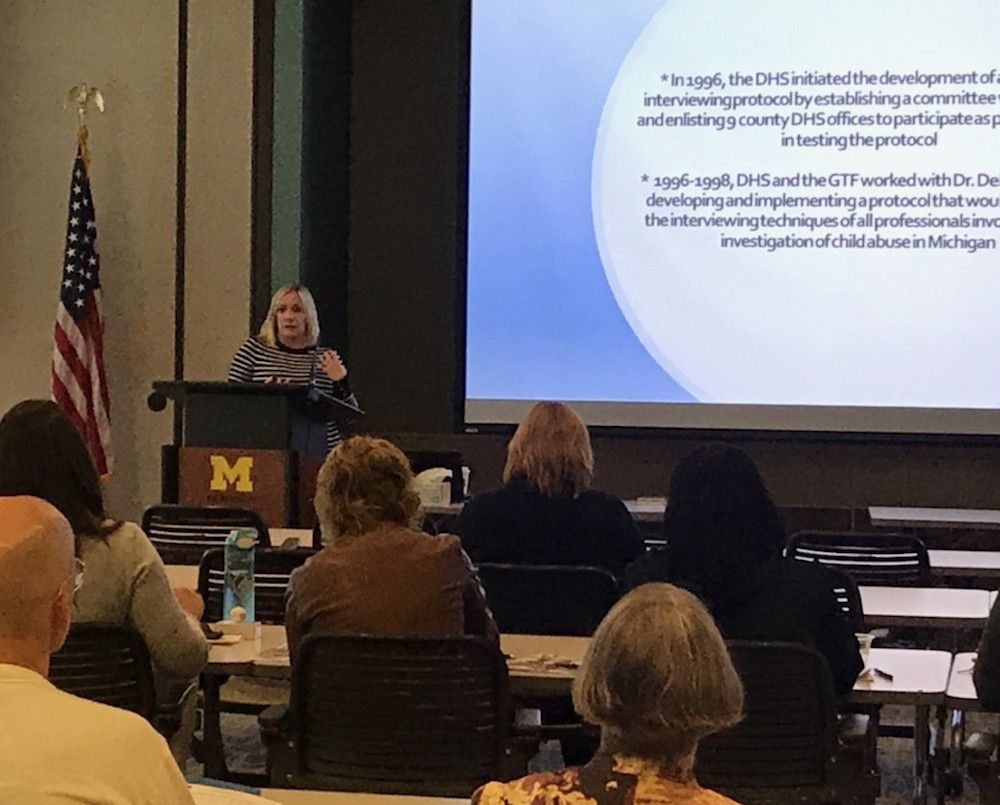
Megan Aukerman, Drug Endangered Children Specialist from the Child Abuse Training Unit of the Prosecuting Attorneys Association of Michigan addresses the symposium.
Professionals from pre-hospital care, EMS, trauma centers and hospitals expanded their knowledge about current state injury prevention initiatives, and the event provided opportunities for networking as well as broad-spectrum tools to promote the latest benchmarks for lowering costs related to injury prevention. Topics included bicycle safety, and a review of Michigan’s Drug Endangered Children (D.E.C.) intervention strategies. Speakers came from the Michigan Department of Health and Human Services, Muskegon Police Department, and the Michigan Department of State.
State Fire Marshall Kevin Sehlmeyer reviewed a powerful initiative funded by a $525,000 federal grant supplying 21,000 smoke alarms in Michigan. Additionally, Mr. Sehlmeyer informed the group regarding current risk statistics, data collection strategies, statistics and resources (search “MI Prevention” for the Fire Marshall’s web page and videos).
Michigan Department of Health and Human Services (MDHHS) Trauma and Toxic Stress Prevention Coordinator, Mary Mueller discussed Adverse Childhood Experiences (ACE) science and Critical Incident Stress Management using Trauma Informed Care initiatives. Mueller focused on how to alleviate secondary trauma among caregivers and lessen compassion fatigue. See MIace.org for related resources.
Riveting emotional testimonies were provided regarding drowning prevention and distracted driving practices. Greatlakeswatersafety.org shows water safety and riptide management strategies, and terrific volunteer opportunities. ItCanWait.org offers multiple approaches to avoid distracted driving, and ways to enhance vehicle safety. Additionally, Sergeant Scott Zonnebelt spoke regarding police in civilian vehicles with the intent to locate drivers who text while driving. Some statistics from the presentation include: 51% – 56% of those polled “admitted” to texting and driving, and the latest discovery that eight people are killed each day in Michigan, related to texting and driving. The group is promoting further funding and an impactful educational push to lessen distracted driving.
The Greater Grand Rapids Bicycle Coalition and the Driving Change Campaign presented a large collection of safety initiatives and collaborations to provide safer biking opportunities on and off the road. Presenters from our Michigan Department of State inspired the group with information from Michigan.gov/OlderDriver, teen driving safety initiatives and transitions and alternatives for drivers. More information is available on the NHTSA Distracted Driving page.
Vendors participated in the conference including pharmaceutical representatives, the Injury Community Implementation Group via Michigan Public Health Institute and the Great Lakes Burn Camp. We graciously thank them for the support.

Shown above are members of the planning committee, plus a couple of speakers. From L to R: Kymberly Pashkowsky, MIPrevention; Maurice Cox, incoming MTC Injury Prevention Chair; Fire Marshall Kevin Sehlmeyer; Karla Klas; Laura Walker; Meaghan Crowley; Kelli Jankens; Donna Buccarelli. Front row: Matthew Budd, Mickie Kreft. Not shown: Nicole Matthews, Sheryl Hurst, Thomas Oweis MD.
Meaghan also sincerely thanks everyone on the planning committee (see above) and all involved in this terrific day. The next annual Injury Prevention Symposium will be held in October 2020 in Mid-Michigan, details coming soon. Registration will be available on the Michigan Trauma Coalition site.
Lansing, Mich. – Hundreds of State of Michigan employees learned how to identify life-threatening bleeding and how they can help intervene in an emergency during a recent training event sponsored by the Michigan Trauma Coalition.
Stop the Bleed instructors from nearly 30 Michigan trauma centers worked seamlessly together to provide an engaging educational experience. Anita Barksdale, BSN, RN, Laura Walker, RN, EMT, CFRN, and Dr. Joel Robinson, DO, FACEP presented lectures to the three classes of DTMB employees September 4, 2019. Volunteer instructors provided hands-on training for over 450 participants, allowing for practice packing wounds and using a tourniquet. “Their efforts made this event possible” stated Matthew Budd, MSN, RN, AGCNS-BC.
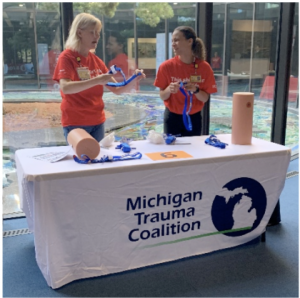 “Tourniquets were taboo for so long and they thought that this was a last-ditch effort and now the evidence is showing that using these sooner can actually save more lives” explained Chris Stimson, BS, RN. “People who come home from this program understand how to recognize what life-threatening bleeding is and when somebody might be in real danger said Budd.
“Tourniquets were taboo for so long and they thought that this was a last-ditch effort and now the evidence is showing that using these sooner can actually save more lives” explained Chris Stimson, BS, RN. “People who come home from this program understand how to recognize what life-threatening bleeding is and when somebody might be in real danger said Budd.
To find a Stop the Bleed training in your area, or to become an instructor, visit www.bleedingcontrol.org, or contact MTC if you are interested in volunteering for future coalition-sponsored training events at [email protected].
 State of Michigan employees will learn life-saving techniques during “Stop the Bleed” training Wednesday, September 4 when the Michigan Trauma Coalition (MTC) visits the Michigan History Center to demonstrate how the public can help during an emergency.
State of Michigan employees will learn life-saving techniques during “Stop the Bleed” training Wednesday, September 4 when the Michigan Trauma Coalition (MTC) visits the Michigan History Center to demonstrate how the public can help during an emergency.
More than 5,000 trauma-related deaths occur in Michigan each year. Bystanders who learn to identify and stop life threatening bleeding can save as many as 20% of people who die from these traumatic injuries.
“Because death due to severe and uncontrolled bleeding can occur in less than five minutes, the importance of teaching basic techniques to slow that bleeding is crucial,” says Sarah Hughes, Registered Nurse and MTC Board member. “Being prepared in the case of an emergency and knowing what to do during severe uncontrolled bleeding may increase a person’s chances of surviving trauma.”
The training event is sponsored by the Michigan Trauma Coalition and sessions will occur at 9am, 11am and 2pm.
With over 90 member hospitals across Michigan, the Michigan Trauma Coalition is the only state wide multi-professional organization dedicated exclusively to the advancement of trauma care, education, research, and advocacy across the trauma continuum.
Planning Stop the Bleed Event for State Employees – You can help
The MTC Injury Prevention Stop the Bleed Group is planning a Stop the Bleed event for the Michigan Department of Technology, Management, and Budget (DTMB) this Summer. 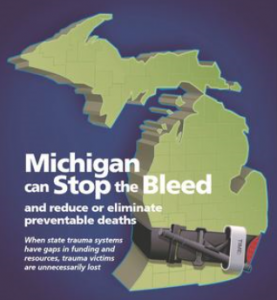
As of May, many DTMB facilities have installed two trauma kits (includes a CAT and a H-bandage) with their AEDs; we want the state employees to feel empowered to use the trauma kits if an emergency were to occur. Many MTC IP members have responded to our doodle poll, but we did want to provide an opportunity for all of our member organizations to contribute to this event. Here is a link to a doodle poll that we are using to plan a date for the event: https://doodle.com/poll/9u5tbaqq28atbcb2
We plan on finding a day to hold three Stop the Bleed Sessions in the Library of Michigan Auditorium, which holds approximately 220 individuals; all together, we hope to educate 660 state employees during the one day blitz! In order to accomplish such a feat, we must recruit between 23-28 instructors for each of our Stop the Bleed sessions.
After we find a date, we will decide upon the times to hold the three courses during the day. In the weeks to come, we will have a sign-up genius for people to sign-up for different roles during our courses.
Please let us know if we can answer any other questions about the upcoming event.
Matthew Budd, MSN, RN, AGCNS-BC – MTC Injury Prevention Committee
Email: [email protected]
Assaultive Violence in the Emergency Department – HB4327
HEALTHCARE FRIENDS! This is really important. Our Legislative and Marketing  Committee has been asking for support for SB80 and requesting that you advocate with your senator to change the wording from ER staff to all healthcare. That bill would make the assault a felony and require signage placed in the hospital notifying that violators would be punished. UPDATE: HB4327 (introduced more recently) does that very thing.
Committee has been asking for support for SB80 and requesting that you advocate with your senator to change the wording from ER staff to all healthcare. That bill would make the assault a felony and require signage placed in the hospital notifying that violators would be punished. UPDATE: HB4327 (introduced more recently) does that very thing.
Specifically: “EXCEPT AS OTHERWISE PROVIDED IN THIS SECTION, AN INDIVIDUAL WHO ASSAULTS, BATTERS, WOUNDS, OR ENDANGERS A HEALTH PROFESSIONAL OR A MEDICAL VOLUNTEER WHO THE INDIVIDUAL KNOWS OR HAS REASON TO KNOW IS PERFORMING HIS OR HER DUTIES IS GUILTY OF A FELONY PUNISHABLE BY IMPRISONMENT OR FINE.” The incarceration or fine rises with the type of injuries received.
WHAT SHOULD YOU DO? Contact you MICHIGAN house representative for your area and advocate for this bill to pass. This puts TEETH in the reporting and prosecution of the dozens of times a week this happens just in our facility. Don’t know who your representative is? Go to the Michigan Trauma Coalition website, to legislative matters, and there is a link where you can type in your address to find your elected officials. From local through the president. For this, you are looking for your State of Michigan House Representative. Call. Email. Email from your work account to give it some weight. Tell them to pass this bill through. Tell a brief story. We all have at least one. We shouldn’t be hurt helping when you are.
House Bill 5217 Signed by Governor – Aims to Limit Air Ambulance Transports
HB-5217 has passed through the house and senate, and signed into law by Governor Snyder. This bill places parameters around air ambulance transport, and as mentioned at the MTC general meeting raises some concerns.  I encourage you to save and print the bill and review it with the appropriate people in your organization. Specifically, Section 21540 raises the possibility of a change in responsibility for payment of the air ambulance cost from insurance/or patient to the hospital if emergency necessity is not adequately documented. It’s important to review your institution’s process for documenting evidence of medical necessity for emergency air transport, to avoid any cost transfer. Some are concerned about possible delays in transport to an appropriate trauma center if multiple air agencies are available as the ED finds the “one” that is “in network for” the patient’s insurance.
I encourage you to save and print the bill and review it with the appropriate people in your organization. Specifically, Section 21540 raises the possibility of a change in responsibility for payment of the air ambulance cost from insurance/or patient to the hospital if emergency necessity is not adequately documented. It’s important to review your institution’s process for documenting evidence of medical necessity for emergency air transport, to avoid any cost transfer. Some are concerned about possible delays in transport to an appropriate trauma center if multiple air agencies are available as the ED finds the “one” that is “in network for” the patient’s insurance.
Most hospitals have their transfer forms worded in such a way that this change of practice may be negligible. Some may not. I encourage you and your administration to contact your outgoing AND incoming representatives to express your concerns. You can find their contact info on the legislative matters page in the “Find your elected officials” link. (Heather Ruffin)
On May 13th, many 31 members of the Michigan Trauma Coalition from a variety of hospitals across the state became car fit technicians. On May 14th, they assisted Karen from AARP and hosted an event where 83 individuals came in to have their vehicles evaluated for proper fit.
CarFit is an educational program that offers older adults the opportunity to check how well their personal vehicles “fit” them. Older drivers are often the safest drivers in that they are more likely to wear their seatbelts, and less likely to speed or drink and drive. However, older drivers are more likely to be killed or seriously injured when a crash does occur due to the greater fragility of their aging bodies. (Source: NHTSA)
Driver safety programs improve adult driver safety by addressing cognitive abilities and skills, however, older drivers can also improve their safety by ensuring their cars are properly adjusted for them. A proper fit in one’s car can greatly increase not only the driver’s safety but also the safety of others
The CarFit program also provides information and materials on community-specific resources that could enhance their safety as drivers, and/or increase their mobility in the community.
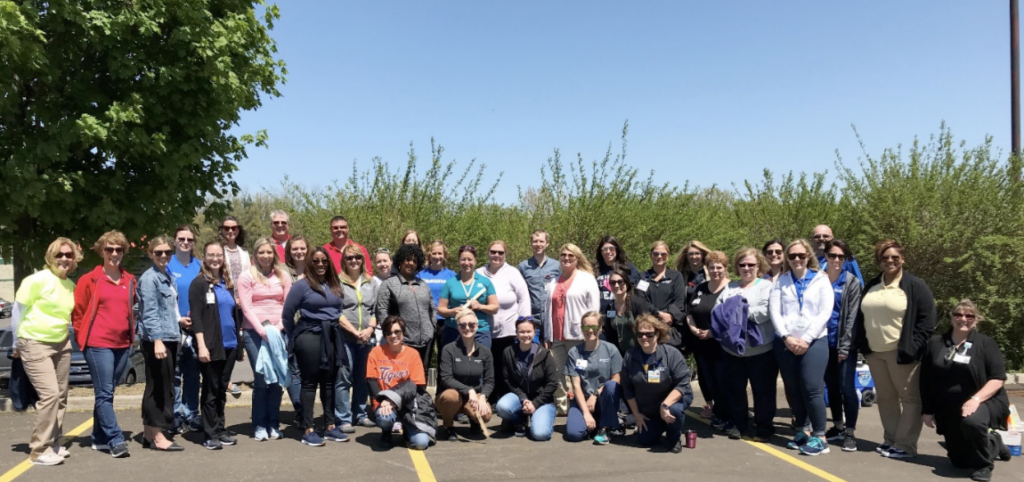
In 2011 the Michigan State Legislature approved funding for a statewide trauma system. The funding was to come out of the Michigan Crime Victims Fund, in the amount of $3.5 million. When the bill was passed, the domestic violence community opposed this funding, as they believed that some of the money would benefit NON-VICTIMS OF CRIME. As a result, language was added stating that in 2014, half of the funding would GO AWAY. Since then, the Legislature passed a law extending the FULL funding of $3.5 million until 2018. As of October 1, 2018, $1.75 million would have been eliminated, if the Legislature hadn’t acted.
To continue the funding, Representatives Henry Yanez (D-Sterling Heights) and Mary Whiteford (R-Casco Twp) both introduced bills. Representative Yanez’s bill would have eliminated the sunset altogether and made the funding for a trauma system much more permanent. This bill remains in the House Appropriations Committee. Representative Whiteford’s bill extends the sunset for another 3 years, so that a full $3.5 million can be expended by the State of Michigan for trauma funding until October 1, 2021. This bill is now law. The link below has the legislative history for Representative Whiteford’s bill.
HB5901 is moving very quickly though the legislature. It passed in the House of Representatives with 69 yes votes and 39 no votes. It now goes to the Senate Appropriations Committee TOMORROW, Wednesday, May 23!
We NEED you to add your information to the downloadable Letter of Support and then send it to your state senator. Encourage your staff to do this as well. Volume matters!
Please be sure to read the template before sending so that all of your information replaces the info in parentheses. Don’t know who your senator is, or how to contact? Click here to find them. You can click through to their respective pages for their contact info. Also, if your hospital is in a different district than your residence you can send two! One as a resident and one as a trauma professional.
We have been working on this for months (years), and the time has come to make the final push. Thanks for all you do for trauma in the state of Michigan. Let’s get this bill passed!
Heather Ruffin, RN, BSN
Trauma Program Manager
Mercy Health Muskegon- Hackley Campus
House Bill 5901 has passed appropriations with 8 no and 16 yes votes. It now goes to the house floor and will be voted on within the week. We NEED you to add your information to this downloadable Letter of Support and send to your representative for your respective areas. Encourage your staff to do this as well. Volume matters! Please be sure to read the template before sending so that all of your information replaces the info in parentheses. Don’t know who your representative is, or how to contact? Click here to find them. It will also provide their contact email. We have been working on this for months and the time has come to make the push. Thanks for all you do for trauma in the state of Michigan. Let’s get this bill passed!
Also, if your hospital is in a different district than your residence you can send two! One as a resident and one as a trauma professional.
On April 26, a large group of multi-disciplinary trauma professionals from around the state rallied at the capital to promote bleeding control education and funding for the Michigan state trauma system: One of only two state systems in the country that lack permanent funding. Heather Ruffin, chair of the marketing and legislative committees for the Michigan Trauma Coalition, and trauma program manager at Mercy Health in Muskegon stated that serveral senators and representatives at the capitol attended along with their staff. With the MTC members in attendance in the gallery, the house passed House Resolution 320 naming April 26 ‘Stop the Bleed Day.’ A bill was also introduced that extended the sunset on the trauma system funding plan. We encourage you to contact your representatives in support of HB 5459. For more information about the legislation or to schedule a Stop the Bleed course for your department or community agency, you may contact Heather at [email protected].
The Injury Prevention Symposium will be held:
- May 21, 2014
- Lansing Community College, 5708 Cornerstone Drive, Lansing, MI 48917
- $35 payment received on or before May 4
- $50 if payment is received after May 4
Due to unforeseen circumstances, we will not be awarding EMS credits at the conference.
Our Third Annual Michigan Pediatric Trauma Conference will be held:
- June 5, 2014
- DeVos Place, Grand Rapids, Michigan
- $50
This conference is being co-sponsored by the Michigan Trauma Coalition and the following hospitals: Beaumont Children’s Hospital, Bronson Methodist Hospital, C.S. Mott’s Children’s Hospital, Covenant HealthCare in Saginaw, Detroit Children’s Hospital, Helen DeVos Children’s Hospital, Hurley Medical Center, Sparrow Hospital, and St. John Providence Children’s Hospital.
Vendor letter and registration
Abstract submission guidelines
Holiday Inn Grand Rapids Downtown Reservations
Warning: Creating default object from empty value in /home/dh_48tdh8/mitrauma.org/wp-content/uploads/espresso/templates/event_post.php on line 60
April 26, 2017 – April 27, 2017
219 S Harrison Rd
Description:
ICD-10-CM/PCS Trauma Training
This 2 day course is designed for Trauma registrars and coders to learn the ICD-10 system and/or enhance their current knowledge. The course will address diagnostic and procedural codes, with in class exercises for coding. An electronic copy of the ICD-10 manual will be placed on the website. Instructors encourage participants to bring their own ICD-10 manuals to class. If you choose to utilize the electronic copy, it is not recommended for a mini iPad or mini tablet.
This training session will be offered on April 26 & 27. The class will run from 8 a.m. until 5 p.m. RHIT, RHIA CE will be provided.
The cost for the 2-day training will be a total of $150 for MTC members.
The agenda for that training is trauma specific and listed below.
Day One:
Eight hours: Basic ICD-10-CM and ICD-10-PCS. Heavy concentration will be on diagnostic coding, ICD-10-CM
- ICD-10-CM
o ICD-10-CM Guidelines pertinent to trauma
o Coma scale
o Fractures
o Use of V00-Z99 as replacement for ICD-9-CM E codes
o Coding practice
- ICD-10-PCS
o ICD-10-PCS Guidelines pertinent to trauma
o Root operations
o Approach
o Coding practice
Day Two:
Eight hours: Basic ICD-10-CM and ICD-10-PCS. Heaviest concentration will be on the procedural coding, ICD-10-PCS
- ICD-10-CM
o ICD-10-CM Guidelines pertinent to trauma
o Coma scale
o Fractures
o Use of V00-Z99 as replacement for ICD-9-CM E codes
- ICD-10-PCS
o ICD-10-PCS Guidelines pertinent to trauma
o Root operations
o Approach
o Coding practice
Please be aware that we do have a cancellation policy. It is posted on the website.

